Anion gap - Study guides, Class notes & Summaries
Looking for the best study guides, study notes and summaries about Anion gap? On this page you'll find 1444 study documents about Anion gap.
Page 4 out of 1.444 results
Sort by
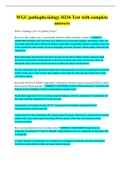
-
WGU pathophysiology D236 Test with complete answers
- Exam (elaborations) • 35 pages • 2023
- Available in package deal
-
- $12.99
- 1x sold
- + learn more
WGU pathophysiology D236 Test with complete answers What is Starling's Law of Capillary forces? How does this explain why a nutritionally deficient child would have edema? How does the RAAS (Renin-Angiotensin-Aldosterone System) result in increased blood volume and increased blood pressure? How can hyperkalemia lead to cardiac arrest? The body uses the Protein Buffering System, Phosphate Buffering System, and Carbonic Acid-Bicarbonate System to regulate and maintain homeostat...
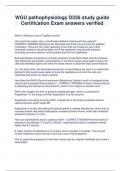
-
WGU pathophysiology D236 study guide Certification Exam answers verified
- Exam (elaborations) • 33 pages • 2024
- Available in package deal
-
- $17.99
- + learn more
WGU pathophysiology D236 study guide Certification Exam answers verified What is Starling's Law of Capillary forces? How does this explain why a nutritionally deficient child would have edema? - CORRECT ANSWER-Starling's Law describes how fluids move across the capillary membrane. There are two major opposing forces that act to balance each other, hydrostatic pressure (pushing water out of the capillaries) and osmotic pressure (including oncontic pressure, which pushes fluid into th...
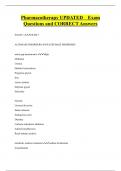
-
Pharmacotherapy UPDATED Exam Questions and CORRECT Answers
- Exam (elaborations) • 102 pages • 2024
-
- $15.99
- + learn more
anion gap mneumonics High: Methanol Uremia Diabetic ketoacidosis Propylene glycol Iron Lactic acidosis Ethylene glycol Salicylate Normal: Ureteral diversion Saline infusion Endogenous acid Diarrhea Carbonic anhydrase inhibitors Adrenal insufficiency Renal tubular acidosis
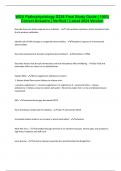
-
WGU Pathophysiology D236 Final Study Guide | 100% Correct Answers | Verified | Latest 2024 Version
- Exam (elaborations) • 16 pages • 2024
- Available in package deal
-
- $12.49
- + learn more
Describe how your body responds to an infection. - T cells produce cytokines, which stimulate B cells. B cells produce antibodies. Identify role of DNA changes in congenital abnormalities. - Mutations in genes or chromosomal abnormalities How does development disrupts congenital abnormalities? - Alterations of DNA Describes factors that disrupt homeostasis and how disruptions affect wellbeing. - (ex) Fluid and electrolyte shifts can cause n/v or dysrhythmias. Explain RAAS - Renin-angioten...
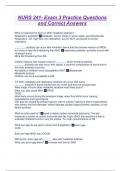
-
NURS 241- Exam 3 Practice Questions and Correct Answers
- Exam (elaborations) • 35 pages • 2024
- Available in package deal
-
- $11.99
- + learn more
What is treatment for burn pt. With metabolic acidosis? Respiratory acidosis? metabolic- correct fluids; in some cases, give bicarbonate Respiratory- O2- high flow, non rebreather- we DO NOT use bicarb to correct respiratory ________ acidosis can occur with inhalation burns and the extreme version of ARDS Is it more or less life threatening than MA? respiratory acidosis- primarily occurs with inhalation burns More life threatening than MA Cellular hypoxia also causes a loss of _______, which w...
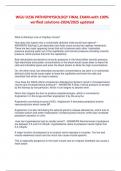
-
WGU D236 PATHOPHYSIOLOGY FINAL EXAM-with 100% verified solutions-2024/2025 updated
- Exam (elaborations) • 32 pages • 2024
- Available in package deal
-
- $15.49
- + learn more
WGU D236 PATHOPHYSIOLOGY FINAL EXAM-with 100% verified solutions-2024/2025 updated What is Starling's Law of Capillary forces? How does this explain why a nutritionally deficient child would have edema? - ANSWERS Starling's Law describes how fluids move across the capillary membrane. There are two major opposing forces that act to balance each other, hydrostatic pressure (pushing water out of the capillaries) and osmotic pressure (including oncontic pressure, which pushes fluid int...
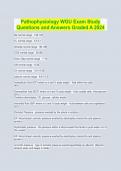
-
Pathophysiology WGU Exam Study Questions and Answers Graded A 2024
- Exam (elaborations) • 24 pages • 2024
-
- $12.99
- + learn more
Na normal range - 133-145 K+ normal range - 3.5-5.1 chloride normal range - 96-108 CO2 normal range - 20-28 Anion Gap normal range - 7-16 UN normal range - 6-20 Crt normal range - 0.51-0.95 calcium normal range - 8.8-10.2 Intracellular fluid (ICF) where is it and % body weight - fluid within the cells 40% Extracellular fluid (ECF) where is it and % body weight - fluid outside cells, intravascular 20% Contains electrolytes, O2, glucose, cellular waste interstitial...
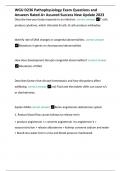
-
WGU D236 Pathophysiology Exam Questions and Answers Rated A+ Assured Success New Update 2023
- Exam (elaborations) • 31 pages • 2024
-
- $10.49
- + learn more
Describe how your body responds to an infection. correct answer T cells produce cytokines, which stimulate B cells. B cells produce antibodies. Identify role of DNA changes in congenital abnormalities. correct answer Mutations in genes or chromosomal abnormalities How does development disrupts congenital abnormalities? correct answer Alterations of DNA Describes factors that disrupt homeostasis and how disruptions affect wellbeing. correct answer (ex) Fluid and electrolyte shifts can caus...

-
GCU BIO322 Exam 1 Pathophysiology Questions And Answers
- Exam (elaborations) • 25 pages • 2024
- Available in package deal
-
- $12.99
- + learn more
Respiratory Alkalosis ~ Arrows in the opposite direction Increased pH Increased HCO3 Hyperventilation Hyperventilation ~ Decreased CO2, H Increased pH = alkalosis associated with resp. alkalosis Hypoventilation ~ Increased CO2, H Decreased pH = acidosis associated with resp. acidosis Anion Gap vs. Non-Anion Gap ~ AG: Na - (HCO3 + Cl) Lactic Acidosis DKA normal: 10-12 Compensated by Increased Cl N-A G: Diarrhea GI loss of HCO3 Fasting vs. Well Fed ~ Fasting: Gly...
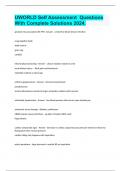
-
UWORLD Self Assessment Questions With Complete Solutions 2024.
- Exam (elaborations) • 25 pages • 2024
- Available in package deal
-
- $8.99
- + learn more
greatest risk associated with TPN - Answer central line blood stream infection coag negative staph staph auerus gram neg candida ethanol glycol poisoning - Answer calcium oxalate crystals in urine acute kidney injury --- flank pain and hematuria metabolic acidosis w anion gap ecthyma gangrenosum - Answer immunocompromised pseudomonas small erythematous macule to larger nontender nodules with necrosis orthostatic hypotension - Answer low blood pressure that occurs upon ...

$6.50 for your textbook summary multiplied by 100 fellow students... Do the math: that's a lot of money! Don't be a thief of your own wallet and start uploading yours now. Discover all about earning on Stuvia


